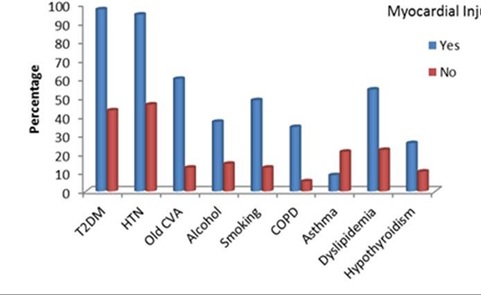Myocardial Dysfunction in Elderly Patients Admitted with Non-Cardiac Diagnosis in Intensive Care Unit
Abstract
Background and Objectives: The diagnosis of acute coronary syndromes can be challenging in patients admitted with the non-cardiac disease to the Intensive Care Unit (ICU). The study aimed to determine the clinical profile of critically ill elderly patients developing myocardial injury who were admitted to ICU for non-cardiac diagnosis.
Materials and Methods: The retrospective study subjects are 130 patients admitted to the medical ICU. Within 24 hours of admission to ICU a detailed history, a 12 lead ECG, CK-MB, Cardiac troponin T was done and as required based on ECG findings and development of clinical symptoms.
Results: Our study showed that 35 out of 130 patients developed acute myocardial injury. 13 out of 35 patients who had myocardial injury had a fatal outcome. The prevalence of hypertension, diabetes mellitus, history of CVA, history of IHD and COPD reached statistical significance (p<0.001) between the two groups of patients who developed myocardial injury and who did not develop a myocardial injury. In patients with multiple comorbidities, the presence of factors like hypoxia, hypotension and the use of vasopressors increases the risk of mortality.
Conclusion: All elderly patients who are hospitalized with or without multiple comorbidities with an acute form of stressors must be evaluated aggressively for precipitants and adequately treated to prevent myocardial injury.
Downloads
References
Klouche K, Jonquet O, Cristol JP. The diagnostic challenge of myocardial infarction in critically ill patients: do high-sensitivity troponin measurements add more clarity or more confusion? Crit Care. 2014 Jun 5;18(3):148. doi: 10.1186/cc13909.
Webb I, Coutts J. Myocardial infarction on the ICU: can we do better? Crit Care. 2008;12(2):129. doi: 10.1186/cc6832. Epub 2008 Apr 3.
Berlot G, Vergolini A, Calderan C, Bussani R, Torelli L, Lucangelo U. Acute myocardial infarction in non-cardiac critically ill patients: a clinical-pathological study. Monaldi Arch Chest Dis. 2010 Dec;74(4):164-71. doi: 10.4081/monaldi.2010.257.
Lim W, Cook DJ, Griffith LE, Crowther MA, Devereaux PJ. Elevated cardiac troponin levels in critically ill patients: prevalence, incidence, and outcomes. Am J Crit Care. 2006 May;15(3):280-8; quiz 289.
Venkatesh CR, Kiran HS, Murthy KAS, Gowdappa BH. Clinical Profile of Atypical Manifestations of Diseases in Elderly Patients Admitted to Critical Care Areas. Int J Sci Stud 2015;3(7):254-58
Ostermann M, Lo J, Toolan M, Tuddenham E, Sanderson B, Lei K, Smith J, Griffiths A, Webb I, Coutts J, Chambers J, Collinson P, Peacock J, Bennett D, Treacher D. A prospective study of the impact of serial troponin measurements on the diagnosis of myocardial infarction and hospital and six-month mortality in patients admitted to ICU with non-cardiac diagnoses. Crit Care. 2014 Apr 4;18(2):R62. doi: 10.1186/cc13818.
Liu M, Shehu M, Herrold E, Cohen H. Prognostic value of initial elevation in cardiac troponin I level in critically ill patients without acute coronary syndrome. Crit Care Nurse. 2015 Apr;35(2):e1-10. doi: 10.4037/ccn2015300.
Bellotto F, Fagiuoli S, Pavei A, Gregory SA, Cati A, Silverj E, Plebani M, Zaninotto M, Mancuso T, Iliceto S. Anemia and ischemia: myocardial injury in patients with gastrointestinal bleeding. Am J Med. 2005 May;118(5):548-51. doi: 10.1016/j.amjmed.2005.01.026.
Senthilkumaran S, Meenakshisundaram R, Ponnuswamy S, Thirumalaikolundusubramanian P. Hypoglycemia and myocardial infarction: Inhibition of ischemic preconditioning response. Indian J Endocrinol Metab. 2012 May;16(3):473-4. doi: 10.4103/2230-8210.95723.
Cakmak M, Cakmak N, Cetemen S, Tanriverdi H, Enc Y, Teskin O, Kilic ID. The value of admission glycosylated hemoglobin level in patients with acute myocardial infarction. Can J Cardiol. 2008 May;24(5):375-8. doi: 10.1016/s0828-282x(08)70600-7.
Goldberg A, Hammerman H, Petcherski S, Zdorovyak A, Yalonetsky S, Kapeliovich M, Agmon Y, Markiewicz W, Aronson D. Prognostic importance of hyponatremia in acute ST-elevation myocardial infarction. Am J Med. 2004 Aug 15;117(4):242-8. doi: 10.1016/j.amjmed.2004.03.022.
Cakmak M, Cakmak N, Cetemen S, Tanriverdi H, Enc Y, Teskin O, Kilic ID. The value of admission glycosylated hemoglobin level in patients with acute myocardial infarction. Canadian journal of cardiology. 2008 May 1;24(5):375-8.
Alatassi A, Habbal M, Tamim H, Sadat M, Al Qasim E, Arabi YM. Association between troponin-I levels and outcome in critically ill patients admitted to non-cardiac intensive care unit with high prevalence of cardiovascular risk factors. BMC anesthesiology. 2018 Dec;18(1):1-1.

Copyright (c) 2021 Author (s). Published by Siddharth Health Research and Social Welfare Society

This work is licensed under a Creative Commons Attribution 4.0 International License.


 OAI - Open Archives Initiative
OAI - Open Archives Initiative


